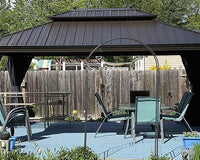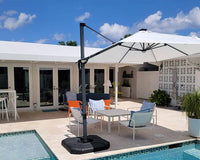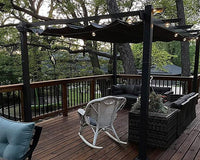So, you found the perfect outdoor dining table. It's the right size, the right style, and it looks wonderful on your patio. There's just one little problem: no umbrella hole. It's a ridiculously common issue, but don't worry—your dream of outdoor dinners in the shade is far from over. In fact, not having a hole in the table actually qualifies you for better, more versatile, and often more stylish shading solutions. This guide will walk you through all the best ways to get the cool, comfortable outdoor dining space you're after.
Why Don’t All Tables Have a Hole?
It may strike you as a strange omission, but there are a few sound reasons why a lot of contemporary outdoor tables don't have an umbrella hole. First, it's a matter of aesthetics. A smooth, unbroken tabletop has a clean, modern appearance that's very popular. It also provides you with greater flexibility when setting the table since there's no pole to interfere with your centerpiece.
The other major reason is the material. Glass, ceramic, or stone tabletops just can't be drilled without potentially cracking or shattering. These tables essentially have a mindset that you'll have an independent shade solution—and as you'll notice, that can be a massive improvement.
The Best Fix: The Cantilever (or Offset) Umbrella
This is the most popular and stylish solution by far, and for good reason. A cantilever umbrella is the style that has a freestanding base and a long curved arm that holds the umbrella over your table from the side. The heavy base and the pole are out of the way off to the side.
How Do They Work?
Picture a large, adjustable floor lamp for your patio. The base, which you fill with sand or water to make it truly heavy, stabilizes the whole thing. The arm then positions the umbrella right over your dining table. Most of these umbrellas have really neat features, like the ability to tilt the canopy to block the sun as it moves or even rotate 360 degrees to shade other parts of your patio.
Why They're Great
The best thing is that there's no pole right in the middle of the table. All your guests can see one another, so conversation is much easier. You also have a lot more versatile shade coverage; you can adjust it to shade the entire table or just one end. And, let's be real, a nice cantilever umbrella looks sharp and makes the entire patio arrangement feel fancier.

What to Keep in Mind
Cantilever umbrellas are well worth the investment, but there are a few things you should know. They are more costly than a standard market umbrella. They also need an extremely heavy base so they don't tip over, so you'll need to make sure you have room for it. And because they are so big, you absolutely have to close them when the wind starts to blow.
The Simple & Easy Option: A Freestanding Umbrella
In case a cantilever umbrella is not within the budget or you prefer something less complicated, you can always utilize an ordinary market umbrella. You simply require a solid, freestanding base to support it. Such bases are generally constructed from cast iron, concrete, or a durable plastic that you can fill with water or sand. A lot of them even feature wheels, making it far easier to shift them around.
You can put the umbrella directly beside your table, tilting it to screen out the afternoon sun. Although the pole will be near the table, it's a really effective and inexpensive solution. Just ensure the base is heavy—50 pounds or more—to prevent the umbrella from tipping over, especially if you happen to catch a little wind.
The DIY Route: Should You Drill Your Own Hole?
This is the one you'd be inclined to try, but wait, read this first. Drilling a hole in your table is a dangerous stunt that can very easily go wrong and permanently damage it. It really ought to be a last-resort solution for certain kinds of tables. 
Warning: Never try to drill through glass, stone, or ceramic. The tabletop will crack.
If, and only if, you have a wood or a dense, solid plastic table and you're very confident in your DIY skills, it's doable. You'd require a drill and a hole saw bit identical in size to your umbrella pole. You'd have to measure diligently and go very slowly. Truly, for most people, the danger of ruining an otherwise perfectly good table just isn't worth it when there are so many other great options available.
Thinking Bigger: Pergolas and Shade Sails
If you want something a bit more lasting and dramatic, however, it's time to think outside the umbrellas.
- Pergolas: A pergola creates a framed "outdoor room" directly above your dining space. A traditional pergola with slats provides a pleasant, partial shade. But for complete control, a louvered pergola is the ultimate indulgence. Its adjustable slats allow you to change between full sun, partial shade, or even a solid roof to completely keep out rain.
- Shade Sails: For a look that's contemporary and dramatic, shade sails are the direction to take. These are big, sturdy pieces of fabric that you stretch tight and fasten to posts or your house. They can cover a broad area and come in trendy shapes and colors and offer a stylish and fairly affordable way to get lots of shade.
Other Creative Ways to Get Shade
If you've got a smaller space or just want something a little different, here are a few other ideas:

- Wall-Mounted Umbrellas: If your table is right up against a wall, these are a brilliant space-saver. They attach to the wall and fold out when you need them, so there's no base to trip over.
- Use a Tree: Don't forget the original shade solution! If you have a nice, mature tree in your yard, placing your dining table underneath it can provide beautiful, natural, dappled shade.
- Clamp-On Umbrellas: For a small bistro table right next to a deck railing, a little clamp-on umbrella can be perfect for shading one or two people.
How to Choose the Right Option for You
Okay, that's a whole bunch of options. Here's how you can narrow it down. Just ask yourself a few questions:
Is your patio windy? If so, a sturdier pergola or a freestanding umbrella that you can easily take down is a more suitable option than a large cantilever that will catch the wind like a sail.
What is my budget? You can spend a little on a standard base or a lot on a custom pergola.
How much room do I really have? Don't forget to leave space for a large umbrella base or pergola posts.
What's your style? Are you aiming for a traditional, homey appearance or a more contemporary, streamlined one?
Embracing the Opportunity of a Hole-Free Table
So, that lovely outdoor table with no umbrella hole? It's not a problem at all—it's an opportunity. It liberates you from being stuck with a pole in the center of your table and allows you to select a shade solution that's much more effective and stylish. Whether you opt for a flexible cantilever umbrella, a fixed pergola, or a trendy shade sail, you can create the ideal shaded area for many wonderful meals al fresco.




